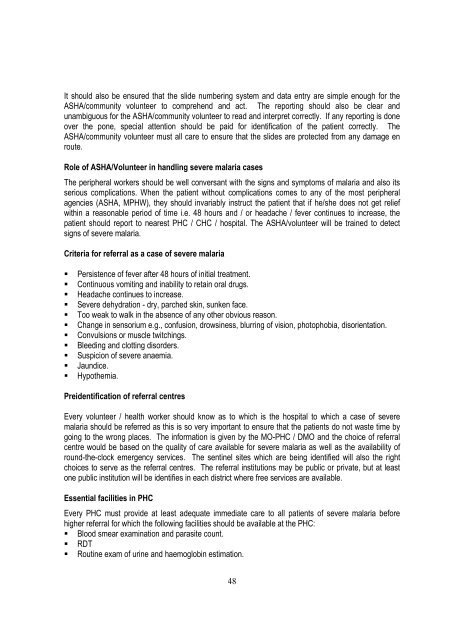training module for medical officers primary health centre - NVBDCP
training module for medical officers primary health centre - NVBDCP
training module for medical officers primary health centre - NVBDCP
- No tags were found...
Create successful ePaper yourself
Turn your PDF publications into a flip-book with our unique Google optimized e-Paper software.
It should also be ensured that the slide numbering system and data entry are simple enough <strong>for</strong> theASHA/community volunteer to comprehend and act. The reporting should also be clear andunambiguous <strong>for</strong> the ASHA/community volunteer to read and interpret correctly. If any reporting is doneover the pone, special attention should be paid <strong>for</strong> identification of the patient correctly. TheASHA/community volunteer must all care to ensure that the slides are protected from any damage enroute.Role of ASHA/Volunteer in handling severe malaria casesThe peripheral workers should be well conversant with the signs and symptoms of malaria and also itsserious complications. When the patient without complications comes to any of the most peripheralagencies (ASHA, MPHW), they should invariably instruct the patient that if he/she does not get reliefwithin a reasonable period of time i.e. 48 hours and / or headache / fever continues to increase, thepatient should report to nearest PHC / CHC / hospital. The ASHA/volunteer will be trained to detectsigns of severe malaria.Criteria <strong>for</strong> referral as a case of severe malariaPersistence of fever after 48 hours of initial treatment.Continuous vomiting and inability to retain oral drugs.Headache continues to increase.Severe dehydration - dry, parched skin, sunken face.Too weak to walk in the absence of any other obvious reason.Change in sensorium e.g., confusion, drowsiness, blurring of vision, photophobia, disorientation.Convulsions or muscle twitchings.Bleeding and clotting disorders.Suspicion of severe anaemia.Jaundice.Hypothemia.Preidentification of referral <strong>centre</strong>sEvery volunteer / <strong>health</strong> worker should know as to which is the hospital to which a case of severemalaria should be referred as this is so very important to ensure that the patients do not waste time bygoing to the wrong places. The in<strong>for</strong>mation is given by the MO-PHC / DMO and the choice of referral<strong>centre</strong> would be based on the quality of care available <strong>for</strong> severe malaria as well as the availability ofround-the-clock emergency services. The sentinel sites which are being identified will also the rightchoices to serve as the referral <strong>centre</strong>s. The referral institutions may be public or private, but at leastone public institution will be identifies in each district where free services are available.Essential facilities in PHCEvery PHC must provide at least adequate immediate care to all patients of severe malaria be<strong>for</strong>ehigher referral <strong>for</strong> which the following facilities should be available at the PHC: Blood smear examination and parasite count. RDT Routine exam of urine and haemoglobin estimation.48
















